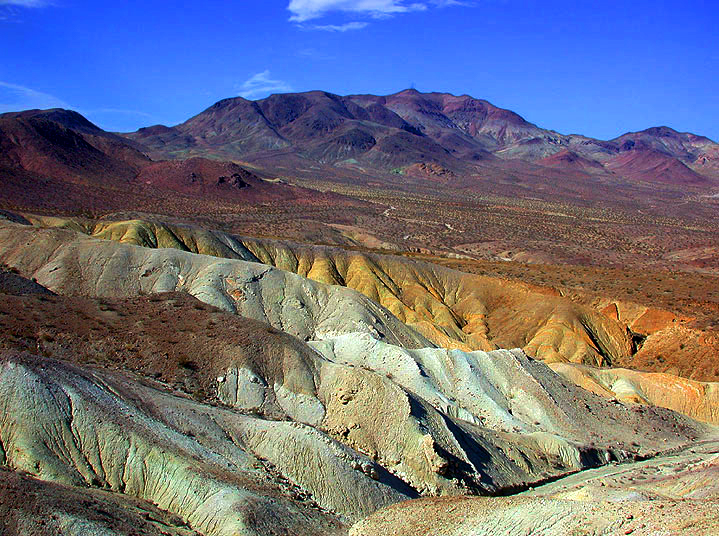
|
Here's a view, looking roughly northwest, across the world-famous fossil arthropod-bearing middle Miocene Barstow Formation in Fossil Insect Canyon, Mojave Desert, California. White to cream-colored and brownish sedimentary strata in the foreground, approximately to center of image, bear an astounding abundance of roughly 17 million year-old fossil fresh water arthropods and plants in distinctive calcium carbonate (limestone) concretions which weather out of the Middle Member of what geologists call the middle Miocene Barstow Formation. In the distance, the reddish-brown rocks at left (slightly above center) and along the skyline belong to a thick series unfossiliferous volcanic extrusives--technically termed dacite--some 17.1 to 16.8 million years old. The remarkable fossil list from the Barstow Formation at Fossil Insect Canyon includes not only many species of insects, but also spiders, water mites, fairy shrimp, ostracods (a minute bivalve crustacean), copepods, (a tiny crustacean, of which Cyclops is best know fresh water type), cladoderans (small crustaceans often called "water fleas"), Chara (green alage), and diatoms (a microscopic single-celled photosynthesizing algae). What's particularly intriguing about the Barstow arthropods and plants is that the specimens can be dissolved out of their calcium carbonate resting places with a diluted solution of acid. In the residues left behind by the chemical reaction, one can find exquisitely preserved three-dimensional fossil remains, sometimes retaining the delicate internal arthropod organs, replaced by a variety of minerals, including chalcedony quartz (silicon dioxide) and celestite (strontium sulfate). |
|
Look to the deep distance in Barstow, California, some 140 miles (225 kilometers) northeast of Los Angeles. All around is the botanically austere, often environmentally harsh Mojave Desert. The burnt reds and browns of the looming mountains appear to be mostly volcanics, a heat-warped jumble of solidified fire-rock, lava, that poured over this part of the earth during what geologists call the Tertiary Period of the Cenozoic Era, 66 to 2.6 million years ago. And, as most fossil enthusiasts understand, volcanic rocks are relatively unlikely sources of paleontologic specimens. Luckily, tucked away among the rugged recesses of a mostly volcanic mountain range, within a reasonable driving distance of Barstow, is a place many seekers of paleontology colloquially call Fossil Insect Canyon. That's where the eroded badlands of an approximately 19 to 17 million year-old lake yield exquisitely preserved arthropod and plant fossils in a world-famous geologic rock unit known appropriately enough as the middle Miocene Barstow Formation: it's a varied assemblage of insects; spiders; water mites; fairy shrimp; ostracods (a tiny bivalve crustacean); copepods (a minute crustacean, of which Cyclops is the most recognizable freshwater species), cladocerans (small crustaceans often called "water fleas"); Chara (a large green algae that superficially resembles a vascular plant); and even diatoms (a microscopic single-celled photosynthesizing algae), all preserved in exceptional three dimensional detail--and, the fossils can be extracted whole and intact from the ancient rocks within which they reside. In all, upwards of 50 species of fresh water arthropods have been identified from Fossil Insect Canyon, a place many paleontologists call a Konservat Lagerstätte. This is by definition a sedimentary deposit that "exhibits extraordinary completeness or richness," preserving for study "lightly sclerotized and soft-bodied organisms or traces of organisms that are not otherwise preserved in the usual shelly and bony fossil record." As a matter of fact, Fossil Insect Canyon is one of only a mere handful of localities on earth where fossil insects can be removed from their matrix without any loss of detail. Probably the best-documented, competing example is paleoanthropologist Louis B. Leaky's description in 1952 of an early Miocene (between 24 and 18 million years old) fauna near Lake Tanganyika, Africa; in that case, the insects had been preserved within a sequence of volcanic ash. Leaky and crew panned the volcanic layers repeatedly, as if searching for gold nuggets in a stream, and extracted many insect remains preserved as calcite (the crystal mineral manifestation of calcium carbonate) molds of the original critters. A more recently discovered deposit that reveals similar sensational insect preservations (reported from a locality that yielded bones described in the scientific literature in 2015) occurs in late Miocene sedimentary material of Nevada's Esmeralda Formation, where silicified fly maggots (AKA carnivorous pupae), replaced by the mineral silicon dioxide, can be removed whole and intact from the vertebrate remains of gomphotheres, an extinct proboscidean that possessed four tusks. In the case of the well-known, spectacular amber arthropod assemblages of the Baltic, Dominican and Colombian areas, it is usually impossible to reliably remove fossils from the hardened tree resin without destroying them, although recent studies with amber from India and Lebanon, for example, suggest that such a process might be regularly feasible. Despite the fact that amber insects are merely desiccated, gossamer-like veneers of their once-living forms, they indeed reveal remarkable external detail of the original animals. These paleontological specimens from Fossil Insect Canyon occur in calcareous (composed primarily of calcium carbonate) concretions that are present within a rather narrow horizon in the middle Miocene Barstow Formation. The insects, associated arthropods, and diatoms can easily be set free by immersing the stones in a diluted acid solution. The fossil fauna accumulated under unique, still incompletely understood geochemical conditions that allowed, in not a few instances, delicate soft-tissue internal organ preservations. It should be pointed out, of course, that the vast majority of Barstow specimens are minute, from around .5 millimeter (one-fiftieth of an inch) to 8 millimeters long (roughly a third of an inch), although the occasional dragonfly larvae can range up to approximately 37 millimeters (inch and a half). For this reason, in order to study in full detail such magnificent preservations, folks interested in actively pursuing the paleontology of Fossil Insect Canyon should certainly invest in at least an inexpensive microscope. For many decades now the fossil-bearing district has provided popular desert recreation. Although regional governmental authorities no longer maintain the dirt road through Fossil Insect Canyon, where visitors now proceed at their own risk along an archetypically neglected desert trail subject to pot-holes, jagged rocks and major flash-flood wash-outs, loads of Mojave Desert adventurers still manage to find their way to the isolated environs--where those who do arrive encounter an obvious major travel restriction. Under the Bureau of Land Managment's Off Road Vehicle Program, travel by automobile must be confined to already existing roads and trails. And use caution when scouting by foot around the multitude of old mines and prospects that penetrate the canyon topography. They are completely unsafe. Never enter them under any conditions. In fact, the locals say that their major rescue problem arises from unsuspecting hikers and trail bike riders who fall into the abandoned shafts. Carry out all garbage, even if trash cans have been provided. There are no regular refuse hauls and sudden high winds can blow someone's waste all over the canyon. Target shooting is permitted, but always choose soft, eroded slopes at which to fire. Many hillsides in the canyon contain abundant volcanic and agate talus too hard to risk a dangerous ricochet. Remember, this is true desert terrain and all camps in Fossil Insect Canyon are dry--no water or wood is available. These items will have to be brought with you. Summer temperatures exceed 100 degrees most everyday (ah, yes, but it's a dry heat, as "they" say...), winter weather turns quite cold, and sudden high winds can spring up without warning all year-round. The most comfortable times for visiting the canyon are from mid to late Fall and early to mid Spring. Less adventurous folks can find lodging and food in either Barstow or Victorville. Once within the confines of Fossil Insect Canyon, having braved the unimproved dirt road in a reliable four-wheel drive vehicle, or at the very least a rugged, dependable truck, paleontology-minded explorers concentrate their attention on the middle Miocene Barstow Formation. Here, it's a varicolored sedimentary sequence exposed in wildly eroded badlands fashion below the immediately overlying (and hence, younger) reddish-brown volcanic rocks--igneous material completely devoid of fossil specimens, of course. The volcanics have been dated at around 17.1 to 16.8 million years and belong to an extrusive brand of solidified lava geologists call dacite. The fossiliferous concretions occur in the sedimentary beds just below the overlying dacites. Credit for discovering the first fossil insect specimen from Fossil Insect Canyon goes to a most-observant geologist, indeed, with the United States Geological Survey (USGS). In January of 1954 he picked up two odd-shaped concretions, one of which had the segmented body of a dragonfly larva partially exposed. This specimen, along with the apparently unfossiliferous stone, was brought to the attention of a USGS paleontologist, who exposed the complete insect through acid etching. When the second sample, without any obvious signs of fossils, failed to yield anything significant, the entire project was about to be abandoned. Then it was learned that a colleague with the USGS had independently collected concretions in the general vicinity of the original discovery with a view of processing them for diatoms (microscopic single-celled algae). Several of these items were obtained and dissolved in a bath of dilute formic acid. This second batch of residues included a water beetle larva, the second fossil insect recovered from the Barstow Formation. With interest in the project now renewed, one of the scientists hurried back to Fossil Insect Canyon to collect several hundred more concretions; all were run through the acid process and produced numerous beautifully preserved insects, spiders, and fairy shrimp. And so began the concretion "Gold Rush"to Fossil Insect Canyon. Today, the fascinating fossil-bearing concretions can still be found in relatively common numbers, although certainly not in the profusion I can recall from but a few years ago. Innumerable representatives of universities, museums, colleges, rockhound clubs, mineral clubs and fossil clubs, as well as individual private collectors have visited Fossil Insect Canyon over the years, so most of the concretion horizons bear evidence of former human presence, in the form of trenches, holes, and quasi-sophisticated mining-style operations. Nonetheless, even after such concerted searchings, the concretions continue to weather out of the microlaminated greenish shales in the upper 30 meters (100 feet) of the middle Miocene Barstow Formation. Concretions are, in addition, most often found just below the contact with the overlying reddish-brown dacite volcanics, in the vicinity of numerous abandoned mines and exploratory prospects (for commercially saleable minerals) that penetrate the canyon's topography. Despite the years of fossil-hunting attrition--several private collectors and professional paleontologists alike report keeping upwards of 25,000 concretions for their projects--the original productive sites continue to provide the best places for concretion gathering. Throughout the canyon corridor, only the lower and middle portions of the middle Miocene Barstow Formation have been exposed through the tireless powers of erosion. So, here the Barstow's roughly 19 to 17 million years old. It consists of approximately 457 meters (1,500 feet) of interlayered lacustrine (lake-deposited) brown shale, greenish siltstone, white-weathering limestone, conglomerate, limy sandstone, tan volcanic tuff, ledge-forming gypsum--and, finally, at the very top of the geologic section, three separate zones of insect-bearing calcareous concretions within the uppermost 30 meters (100 feet) of greenish microlaminated shale, just below the overlying volcanic dacites. All three concretion zones occur only within those extremely fine-grained, geologically youngest microlaminated shales, which reveal on average roughly 25 double annual bands (varves) per 2.5 centimeters (one inch). At that incremental rate of sedimentary deposition, the concretion-precipitating period of middle Miocene Lake Barstow (a name coined by a major "Barstow bug" researcher, by the way) lasted some 30,000 years. Each distinct concretion horizon is one meter (3.28 feet) to three meters thick and bears four individual layers of arthropod-yielding concretions. One additional calcium carbonate concretion layer produces no arthropod body parts, but does yield abundant fairy shrimp coprolites. Underlying the Barstow in Fossil Insect Canyon is the unfossiliferous, primarily pyroclastic-volcanic Pickhandle Formation of late lower Miocene age, around 19.4 to 19 million years old. Recent geological reconnaissance suggests that the lower layers of the Barstow Formation in Fossil Insect Canyon interfinger with the dominantly volcanic Pickhandle section and were therefore deposited contemporaneously, at least in part, as Pickhandle volcanic activity subsided. The Barstow Formation calcareous concretions formed under still incompletely understood geochemical conditions, although one recent scientific analysis of their diagenesis arrived at some interesting conclusions. The investigators decided that concretion development initiated as a result of abundant decaying organic matter in the Miocene paleo-ecosystem--a ripe combination of putrefying fecal material, cyanobacteria (blue-green algae), aerobic bacteria, anaerobic bacteria, aquatic arthropods and plants, primarily. As this "rot sludge" released carbon dioxide (CO2) and ammonia (NH3), alkalinity increased locally in the pore waters. But, that was still not enough geochemistry to stimulate concretion growth. According to the investigations, something else was needed to boost the alkalinity level to a critical point--and that special catalyst was probably the element boron. Since the fossiliferous concretions lie in close stratigraphic proximity to bedded ores of borates, the scientists speculated that perhaps the periodic introduction of boron to the ecosystem, through local hot springs, brought alkalinity to the proverbial tipping point. That final boron boost then produced a necessary rise in carbonate ion concentration, which in turn facilitated precipitation of calcium carbonate (limestone) concretions that trapped and preserved the remarkable Barstow arthropod fauna. It is an elegant solution to the problem, indeed. Calcium carbonate concretions that yield three-dimensional insects, amenable to acid treatment for their removal, are found only within a restricted geographic area of California that bears bedded ores of borates. Without boron--no "Barstow bugs." It was that "simple," perhaps. Whatever the eventual explanation might be, the concretions probably developed in at least an above-normal saline lacustrine environment--but, not necessarily one of extremely high brine alkalinity. Appreciable saline content is proved by the sudden appearance of zeolites--defined mineralogically as microporous aluminum silicates--in the microlaminated shales that yield the concretions. Used widely as water purifiers, in cat litter and in manufacturing laundry detergent, zeolites generally form naturally from the reaction of volcanic glass with connate water trapped during sedimentation in saline, alkaline lakes. Shales both above and below each concretion zone lack zeolites, suggesting that for many thousands of years, until occasional concretion-forming episodes occurred, Lake Barstow existed within an average range of alkalinity without significant contributions of volcanic ash. Also, because the regularly bedded microlaminated shales lack the element iron and show no signs of bioturbation, the concretions likely grew within dysaerobic conditions (extremely low oxygen content). And, finally, rapid fluctuations of the lake's water level, which introduced on a sudden plentiful mineral solutes from the surrounding countryside, as well as depriving the lake of sediments (when water levels dropped rapidly, for example), could have contributed substantially to the preservation of the middle Miocene Barstow arthropod fauna. This comports well with the observation that the seasonal layered laminations (varves) of shales within each concretion-bearing zone actually become dramatically thinner than those shales both above and below the fossil horizons, pointing to probable cyclic pulsations of prolonged sediment starvation combined with concomitant concentration of alkaline constituents through evaporation, ultimately contributing to concretion development in the presence of zeolites derived from occasional influxes of volcanic ash. That significant evaporation took place during concretion growth is proved by two independent analyses of oxygen isotopes contained in the concretions. Both scientific studies demonstrated that the specific ratios of oxygen isotopes observed could have developed only under conditions of gradual and then, eventually, an almost complete evaporation of the lake waters. Additionally, concretions successively higher in the geologic section (proceeding up the geologic column to younger zones) at Fossil Insect Canyon bear distinctive carbon isotope signatures that point to a progressive increase of decaying vegetation during Lake Barstow's history. This agrees well with practical field experience at Fossil Insect Canyon, where many collectors remark that the uppermost concretion zone smells "funkier," more distinctly fetid than the older two horizons--the primary reason being that the youngest concretions contain more "aromatic" petroleum. Of course, classically, such calcium carbonate concretions precipitate when mineral matter accumulates in the pores of sediments around a nucleus or center, such as a silicified organism; and, they develop after the sediments are deposited because the bedding planes of the formation within which they lie pass through them. In polished cross-sections, concretions from Fossil Insect Canyon reveal distinct alternating dark and white bands (layers), the latter composed almost entirely of minute fairy shrimp fecal pellets (coprolites); the three-dimensional fossil arthropods occur not only at the center of the concretions, but also scattered randomly throughout them in a horizontal bedding orientation. Clearly, it would seem, the concretions developed after many layers of sediments containing arthropods had already been deposited; sediments both above and below concretions observed in-place (not weathered out) are distorted from their natural horizontal planes of deposition to conform to the rounded concretion preserved within the shales. This provides compelling evidence that the concretions originally grew within the sediments, expanding and warping the soft layers above and below them during development--not as calcareous accumulations that poked their "heads" above water before their compete burial. Some concretion centers display small mineral crystals, or even vacant spaces, presumably where droplets of petroleum migrated during concretion development. Not content with the standard models, several investigators have proposed alternate physical processes to explain the Barstow Formation concretions. One possibility offered is that the concretions represent miniature oil reservoirs, that perhaps calcium carbonate precipitated when stimulated by incipient oozings of petroleum, derived from decaying aquatic arthropods, fecal material, and cyanobacteria (blue-green algae), primarily; in this scenario, boron plays a significant role as a catalyst for petroleum migration to the concretions. Another line of thought holds that the concretions are actually stromatolites, not classically created through cyanobacterial activity, but rather by an unknown, presumably extinct organism adapted to the unique geochemistry of such boron-precipitating middle Miocene lake systems in what is now the Mojave Desert of southern California; the specific champion of this hypothesis points to the fact that each concretion is an entity unto itself--not a member of a vast algal mat. A more recent proposal suggests that the fossil-bearing concretions can be identified as "coproherms," calcareous accumulations that enveloped aquatic arthropod poop (fecal material derived from fairy shrimp and water-living insects, mainly). Favoring this line of thought is that most concretions in cross-section reveal alternating bands of calcite and fairy shrimp fecal pellets. Perhaps cyclic, repeated local concentrations of dying fairy shrimp, and other aquatic arthropods in ever-evaporating, oxygen-depleted, mineral-charged waters finally helped alter to a critical point--after many such successive death struggles--the lake's geochemistry, now allowing calcium carbonate precipitation around pockets of entire masses of layered coprolites, simultaneously preserving the remains of insects, arachnids, crustaceans, diatoms, and Chara (green algae) already stratified in the bottom muds from past death cycles. Another creative explanation postulates that concretion growth was stimulated by water beetle larvae, which actually leave the water to pupate, excavating distinct spherical, oval or pyriform cells (slight depressions) up to 5 centimeters (2 inches) or more in diameter in the shoreline muds. That's the general size and shape of many Barstow Formation concretions; such larval cell depressions could have provided ready-made spaces for calcium carbonate precipitation after fluctuations of the water level flooded the excavations. An additional idea is that the green algae Chara stimulated concretion growth; modern Chara characteristically grows in hard-water alkaline lake conditions, and calcium carbonate regularly precipitates around their branching structures. Perhaps prolific fragments of Chara, already accumulating in calcareous layers, were the ultimate loci of concretion formation. Lower in the Barstow Formation, in strata geologically older than the insect-bearing concretion zones, localized fossil Chara deposits form what lithologists describe as phytoherms--that is, rounded, roughly spherical masses of tangled Chara branching structures preserved in place in strata dated at approximately 19 million years old. Within the 13 distinct concretion-bearing beds, the fossiliferous oddities are typically 6 millimeters (quarter-inch) to 64 millimeters (two and a half inches) in diameter and weather out in a variety of shapes: spheres, hemispheres, discs, cones, "derby hats," and even mammillary types. Each kind may yield one or more fossil specimens. One concretion in my collection produced no fewer than twelve beautifully preserved specimens. On the other hand, some of the calcium carbonate precipitates are, of course, fossil-free. There is no sure way to determine which concretions are fossiliferous, so it is best to keep all that are found. The percentage that contain fossils will depend on which of the 13 concretion horizons is explored. For example, the lower and uppermost nodule zones produce significantly fewer arthropod remains than the middle horizon. Although abundant agate, gypsum, and volcanic talus often litter the concretion-bearing hillsides, the stone paleo-tombs themselves are quite distinctive. They typically show concentric lamination on their weathered exteriors and will fizz when tested with a dilute acid solution, as they are composed primarily of calcium carbonate. In addition, when found in place in the shales, the hemispherical varieties typically have a flattened surface up and a rounded side down. Collecting the insect-bearing concretions is certainly not difficult. As a matter of fact, it is a most enjoyable and educational experience to sit on a hillslope overlooking the variegated badlands, to dig a bit here and there, placing the strangely contoured concretions in any handy container. They've been around some 17 million years and, even if a few should crack while in transit it really doesn't matter because they have to be dissolved in acid in order to obtain the prize fossils they contain. Once you've collected a "few" nodules and taken them home, you are ready for a most important step: dissolving them in a dilute acid solution. It should be pointed out that, although some collectors prefer acetic acid (glacial, not that found in white vinegar, which works way too slowly and imparts too many impurities to the chemical reaction), my experience shows that dilute formic acid, five parts water to one part acid, serves better. A number of "Barstow bug" aficionados advocate, instead, dilute muriatic acid--that is, commercial grade hydrochloric, available at any home improvement emporium. Both the mixing of the acid and dissolving of the nodules must be done in glass or plastic basins. When diluting the acid, never pour water into the acid; this could cause a sudden overheating of the mixture with a resulting splattering of the acid-laden solution. The full strength acid should be poured into the pre-measured water. Safety goggles must be warn at all times! Be careful! The exact method used to dissolve the concretions is an individual decision. Possibilities range from sophisticated scientific laboratory procedures available mostly to university personnel to those less efficient but more accessible. I've found that lining a medium-sized casserole dish with aluminum foil gives all the space to dissolve about five or six medium-sized paleo-prizes. It is, among other things, more efficient to work with relatively smaller amounts of the insoluble residues, from which the silicified fauna is extracted. Fill the basin to the brim; leave the brew uncovered; be sure to conduct the dissolving operation where there is good ventilation and nothing is nearby that would be corroded by the fumes. The chemical reaction that takes place between the calcium carbonate and the acid generates a pungent stench. Added to the malodorous emanations is a distinctive fetidness that arises from the small amounts of petroleum released from the bubbling concretions. All in all, it is a pretty stinky situation. If only a few medium-sized concretions are set into reaction, the dissolving will take only a few hours to complete. Often, though, the process will require more than an overnight period. Experience soon will show one how many concretions can be dissolved completely by a given volume of acid solution. After the concretions have been thoroughly dissolved, neutralize any remaining active acid with sodium bicarbonate and then carefully dispense with the spent solution, obeying all local and federal regulations regarding the disposal of such hazardous material. Now, carefully and gently rinse the residues with fresh water. This is to prevent caking due to by-products of the chemical reaction, which can obscure key characteristics of the fossils. When the residues have dried completely, the fossils are ready for study. At this point, even an inexpensive microscope will come in handy, because the vast majority of specimens range in size from a little less than one millimeter (less than one twenty-fourth inch) to around 8 millimeters (a third of an inch) long. A stereoscopic dissecting microscope works especially well, but for some the cost may be prohibitive. Transfer small portions of the insoluble residues to a clean sheet of colored construction paper. As most of the fossils are the color of opaque glass, the contrast in color makes them easier to spot. Then, scan them with a hand magnifying glass of ten or more power. If the microscope in use has a black metal plate, one's efficiency in spotting the fossils can be greatly increased. The silicified fossils that are found can be moved to special microfossil slides for storage and study by lightly touching them with a fine-pointed dampened artist's brush. These microfossil slides usually come in two basic types and can be procured from a commercial laboratory supply house. Each is the size of a standard glass microscope slide, but they are usually made of cardboard. One variety traditionally has separate compartments in the shape of circles; the others are either square or rectangular shaped. The microfossil specimens are placed in these compartments. If these particularly useful slides are not available, the fossils from the Barstow Formation can be secured to regular glass microscope slides by applying a minute amount of well-diluted white glue (so that the glue does not obscure the specimen). Ingenuity is the name of the game here. Manner of storage of such fragile microfossils is purely an individual decision, quite obviously. The Barstow Formation fauna of Fossil Insect Canyon consists of five dominant varieties, all of them exclusively aquatic in habitat--they constitute, as a matter of fact, fully 98 percent of all fossil finds. By far, the three most abundant forms found are: pupae belonging to a midge (adults infrequently found), Dasyhelea austalis antiqua, a variety whose closest living relative is Dasyhelea australis australis, now found on the islands of Isles Juan Fernando, approximately 400 miles west of Santiago, Chile--the pupal period for midges lasts only five to seven days, and within the Barstow concretions every stage has been preserved, even up to adults caught forever in time emerging from their pupal cases; larval predacious water beetles, Shistomerus californense (adults rare), of a species most closely related to the modern Deronectes striatellus, today widely distributed throughout the southwestern United States; and fragmentary remains of a fairy shrimp (adults common, though mostly complete specimens extraordinarily rare), called scientifically Archaebranchinecta barstowensis, whose closest living relative is Archaebranchinecta pollicifera, now native to the mountains of Bolivia and Peru, around Lake Titicaca; their fragmentary presence here is in itself remarkable, as fairy shrimp have absolutely no genuine hard parts to begin with. The abundant fairy shrimp in Lake Barstow also contributed enormous quantities of minute coprolite pellets to the calcareous concretions, discrete fecal rods only a fraction of a millimeter long (much less than one twenty-fourth of an inch). Often such pellets are so abundant that they form successive, multiple layers within Barstow concretions. Two additional dominants in the Barstow concretions remain far less commonly recovered: a species of dragonfly (larvae only) that most closely resembles the Caribbean dragonfly, Orthemis ferruginia; and larval water mites, called scientifically Protoarrenurus convergens, which is most like the living genus Arrenurus of world-wide distribution. Much rarer paleontological specimens recovered in three-dimensional glory from the calcium carbonate concretions at Fossil Insect Canyon include: two additional species of midges (pupae and adults); black flies/gnats (pupae and adults); mayfles; aphids; book lice; rove beetles; termites; true bugs; thrips (at least three species); flower beetles; carrion beetles; rove beetles; ants, leafhoppers (three species); grasshoppers (larval forms); parasitic wasps; springtails; bush crickets; stink bugs; psyllids; mantidflies; butterflies (based on two species of caterpillars); mosquitoes; bee flies; bees; termites; ostracods (a minute bivalved crustacean); copepods (a tiny crustacean; Cyclops is the best know freshwater genus); cladocerans (a small crustacean often called "water fleas"); and jumping spiders (more than one species). In all, upwards of 50 species of fresh water arthropods have been identified from Fossil Insect Canyon. Plant remains identified include 5 species of diatoms (microscopic single-celled algae), mosses and moss spores, Chara branches and spore cases, plus unidentified twigs, leaves and seeds. The fossils are typically preserved by opaque white to crystal clear chalcedony quartz, although some specimens seem impregnated with a reddish organic compound of unestablished chemical structure. Other replacing minerals are celestite (strontium sulfate), gypsum (calcium sulfate), calcite (crystalline form of calcium carbonate, seen only in dragonfly larvae that have been exposed by weathering), analcite (a zeolite of sodium aluminum silicate structure formed by volcanic ash reacting with alkaline lakes waters), and bassanite (a saline evaporite, consisting of calcium sulfate--it was identified at Mount Vesuvius, interestingly enough). One of the remarkable features of these fossils is the fact that the internal organs of some of the animals have been preserved intact--particularly the brains and trachea of larval water beetles, Shistomerus californense; internal structures of dragonfly larvae (Orthemis sp.--a type now known from the Caribbean); and unhatched adult midges still in their pupae. Thus, the "Barstow bugs" are certainly not internal mineral fillings, or molds of the original animals. Mineral replacement took place soon enough after death, or in such a perfected chemical environment that in many instances the internal organs never disintegrated. Through the decades, several formal, professional scientific analyses of the Barstow fauna prove conclusively that all concretion horizons yield mainly immature varieties of arthropods that lived most of their lives in water: a dominantly aquatic assemblage, indeed, characterized by larvae and pupae of midges, larval water beetles, larval dragonflies, larval water mites, and immature and adult fairy shrimp; terrestrial, non-aquatic creatures are of course well-represented by adults, and actually account for a greater number of species than the purely water-thriving forms. It's just that such adult specimens constitute but two percent of the total take, so that on average, for every 100 fossils recovered from the concretions, only 2 will be an adult. Additionally, distribution of both immature stages and adults in the fossil fauna is such that, for the most part, adults are more common in the easternmost Barstow Formation exposures of Fossil Insect Canyon, while the midge pupae seem highly concentrated in the westernmost outcrops. Perhaps the explanation, offered by one particularly paleo-perspicacious Barstow investigator, is that prevailing winds blew from east to west during concretion formation. That meteorological scenario would theoretically blow many more adults into the eastern waters of Lake Barstow, and then drive the poorly motile midge pupae toward the western end, where sometimes great numbers are encountered, fused together as if they had formed extensive sheets on the surface, prior to preservation. Perhaps supporting this idea is that the more actively mobile predacious water beetle larvae ("water tigers") can be found in evenly distributed numbers throughout Fossil Insect Canyon, arthropods apparently unaffected by winds or mild currents. In an immature state, present-day aquatic insects and hatching fairy shrimp dominate the fauna of fresh-water basins during late winter or springtime. So the inference is that an assemblage deficient in adults was dependent on seasonal chemical conditions in the bottom muds of the ancient lake which favored preservations. Adult water beetles and water mites, for example, were obviously present during other times of the year, but were not preserved because some strangely restricting conditions in their environment were not then favorable for concretion formation--conditions most likely associated with unique bottom mud geochemistry. Or, perhaps adults, for whatever reason, were simply less amenable to preservations in the concretions. Yet another explanation is that adults have been replaced by calcite or some other mineral which dissolves away during acid treatment for removal. Barstow concretion ostracod remains, for example, have been identified only from their exceptionally well-preserved soft tissues (a unique occurrence for ostracod specimens); their distinct bivalve shell covering dissolves away during an acid bath, leaving only a telltale imprint pattern in the residues, proving to researchers that the shell was there, prior to the acid dunking. Speaking of which...somebody needs to deploy a virtual, digital thin-sectioning technique, whereby the concretions are "sliced" into micro-thin sections and then assembled through computer technology into a three-dimensional display of the cuttings--so that one may actually peer into a concretion from every conceivable angle, without ever having to dissolve it away. In other words, run them through synchrotron imaging, or even a CAT scan, if at all possible. Among many exciting scientific observations imaginable, one could then view every species of arthropod preserved within, not having to worry whether the acid bath destroyed something organic--plus, learn with unambiguous certainty how each individual fossil specimen is orientated within the concretion. In an attempt to better understand Lake Barstow's paleo-environmental middle Miocene times, many "Barstow bug" investigators draw a modern comparison with Soap Lake in central Washington, although not a few folks find California's Mono Lake a better present-day analog, not to mention Borax Lake in southeastern Oregon, for that matter--which, incidentally, remains the sole place in North American where, today, boron actually precipitates into a lake system. Found living at Soap Lake, in a highly alkaline environment, are larval water beetles, fairy shrimp, and pupae of aquatic insects amazingly similar to species recovered from Fossil Insect Canyon's concretions. So it is indeed possible that relative concentrations of alkalinity controlled the fossil fauna's variety. This also agrees with the mineralogical evidence. The fossiliferous concretions occur in association with barites (barium sulfate), celestites (strontium sulfate), borates (ores of boron) and gypsum (calcium sulfate)--all of which signify a decidedly briny, concentrated alkaline environment. It should be pointed out, though, that Lake Barstow never existed within a classically defined desert, so the comparison with modern major hydrologic systems in the American arid west is probably not convincingly analogous. Whatever environmental factors caused significant evaporative processes during middle Miocene times in what is now Fossil Insect Canyon, deposition under conditions akin to Recent (within the past 10,000 years) deserts can probably be eliminated. Alternately, it is entirely possible, of course, that for most of its existence, for thousands upon thousands of years between concretion growth cycles, Lake Barstow was a perfectly average freshwater basin, with normal variations of alkalinity. Then, as the waters gradually evaporated, or perhaps became poisoned by borates and a combination of mineral solutes infused into the hydrologic system from thermal springs and/or volcanic activity, fewer creatures could tolerate the increasingly saline-alkaline conditions, flying away, escaping to live another day, until finally even the hardiest of inhabitants--the fairy shrimp, water beetle larvae and midge pupae, predominantly, eventually succumbed, many of which fortuitously found their way into calcareous concretions, silicified, preserved in crystalline three-dimensions for millions of years. Such a grand cyclic repetition of arthropod preservations--there are 13 distinct, individual beds of fossil-bearing concretions, stacked one atop another in normal stratigraphic relations, separated by many meters (one meter equals 3.28 feet) of unfossiliferous shale--neccesitates a causative agent, some primary generator of concretion precipitation that every several thousand years or so captured vast numbers of delicate arthropod remains. That unifying explanation has never been satisfactorily delivered. But, an intriguing proposal involves regional emplacement of silver ore. On the Mojave Desert, within a reasonable distance of Fossil Insect Canyon, lies a famous silver-producing district. The ore bodies were mined extensively in the late 1800s and yielded unfathomable riches from numerous bonanza bodies situated in rocks hydrothermally altered at relatively shallow depths 17 million years ago. The volcanic dacites that outcrop in the immediate area are 17.1 to 16.8 million years old, and the specific age of the dacite that caps the Barstow Formation in Fossil Insect Canyon is 16.8 million years old. By the laws of geological superposition, the underlying Barstow Formation is therefore older. Between the youngest concretion horizon and the overlying dacite are several meters of barren Barstow sediments. Probably that uppermost concretion bed in the Barstow Formation is around 17 million years old. And that age coincides with a dramatic up-welling of super-heated silver-bearing fluids--and dacite extrusive lavas--from deep in the earth, bringing with them any number of associated minerals, including boron, barium and strontium--all of which could have been expelled into ancient Lake Barstow through thermal springs during occasional pulsations of ore and lava upwards through the crust. During that specific period of silver ore emplacement, lasting several thousands of years, Lake Barstow could have on occasion coincidentally evaporated enough to concentrate the minerals--most importantly, boron--the proposed necessary catalyst for Barstow concretion growth. Or, perhaps the dacite extrusive eruptions themselves, cyclically timed to hydrothermal silver pulsations, repeatedly killed all life in the middle Miocene lake. Whatever the triggering mechanism might have been for their formation, those concretions have provided an unprecedented opportunity to gaze backward in geologic time to a complete three-dimensional insect world that can literally be held in one's hand. Paleoentomology has never been quite the same since that January, 1954, discovery of the Barstow Formation arthropods in Fossil Insect Canyon. The fossil arthropods, diatoms (microscopic single-celled algae) and Chara (green algae) inform much about the paleo-environment of the ancestral Mojave Desert province some 17 million years ago. Straightaway, of course, it is important to remember that during middle Miocene times the modern Mojave Desert did not exist. The North American deserts we recognize today did not develop until the end of the Ice Age Pleistocene Epoch roughly 10,000 years ago. Taken as a whole, what the paleo-treasures in Fossil Insect Canyon show is that the temperatures ranged from hot to mild, with moderate aridity and nearby humid microclimates. Rainfall probably was in the neighborhood of 15 to 25 inches per year (38.1 to 63.5 centimeters), and that distributed substantially in both the summer and winter months. Today, Barstow--a number of miles distant from the fossil district, though still considered representative of Fossil Insect Canyon weather conditions--receives roughly 5 inches per year (12.5 centimeters). The thrips, aphids, true bugs, leafhoppers, grasshoppers, and ants show that the surrounding countryside was likely predominantly grassland, although there were scattered patches of woodlands, or even extended savannas, as evidenced by the carrion beetles, termites, and flower beetles. Most of the terrestrial insects lived in grassy plains and meadows or in weedy patches along the shores of the lake. The evidence from Lake Barstow's terrestrial insects jibes with what can be inferred from paleobotanical data--a grassy plains region in the lowland lake basin, with scattered patches of woodlands, giving way at higher elevations to a greater diversity of botanic life. Although no fossil leaves occur in the shales at Fossil Insect Canyon, a famous locality in the Tehachapi Mountains along the western border of the Mojave Desert province provides a valuable insight into probable middle Miocene plant communities at slightly higher elevations surrounding Lake Barstow. This so-called Tehachapi Flora occurs in the lower stratigraphic intervals of the Bopesta Formation, dated radiometrically at 17.1 million years old--practically the same geologic age as the Bastow Formation arthropod fauna. It preserves in fine detail, within a bed of lithified volcanic ash, fossil leaves from a variety of trees and shrubs whose modern-day relatives grow in the riparian habitats, oak woodlands and subtropical scrub associations of southwest Texas, southern New Mexico, southeastern Arizona, southern California, and northern Mexico. By studying the Tehachapi paleobotanical record, the Cenozoic scene in the vicinity of Lake Barstow becomes clearer. Around the streamcourses thrived Miocene species of sycamore, cottonwood, willow, maple, hackberry, avocado, and palm; their living representatives now live in the summer-wet regions of the southwest United States and northern Mexico. Higher up along the slopes grew an oak-pine woodland consisting of Miocene ancestors of canyon live oak, Engelmann Oak, Nuttall's scrub oak, Arizona White Oak, Arizona Cypress, Mexican Pinyon Pine, New Mexican Locust, Fremont's mahonia, Mexican madrone, and Texas madrone, among others. The overall composition of the fossil flora suggests a climate of mild, frost-free winters and ample summer rainfall. The aquatic Barstow arthropods add even more detail to the story. They indicate a shallow warm-water lake, poorly oxygenated, at times covered in thick blankets of blue-green algae (cyanobacteria). This is proved by the profusion of midge pupae, which require algae-choked conditions to thrive. Modern midge larvae and pupae cannot tolerate salinities (NaCl) above 14 percent, and the presence of non-biting Dasyhelea australis antiqua midges shows low oxygenation. Adult predacious water beetles and their larvae generally prefer stagnant water, such as ponds and lakes, or slow-moving streams; as a biological family, the Dystiscidae (predacious diving water beetles) are quite tolerant of wide variations in salinity, though a few species can be eliminated with only minor changes in salt levels. The adult water beetles are strong flyers and are known to flee habitats affected by drought. Fairy shrimp can withstand great variations of salinity, and in fact require a minimum NaCl level of 3 percent, but curiously the species identified from the Barstow concretions most closely resembles a type now native to temporary shallow pools in high-Andes bofedal peatlands near Lake Titicaca, Bolivia and Peru; their amazing abundance in the middle Miocene lake proves there were no endemic predators present--in other words, fish. Fairy shrimp require water temperatures above four, to possibly six degrees centigrade (39 to 43 degrees Fahrenheit) and cannot survive sub-alkaline waters below a pH level of 6.8 (anything above 7.0 is alkaline), though some species easily withstand extreme pH readings of 9.5. Generally speaking, fairy shrimp and water mites prefer pH levels between 7.0 and 7.5 (only mildly alkaline). According to one scientific report, the ostracods (minute bivalve crustacean)--preserved as unique, unprecedented soft-tissue mineral replacements--suggest a permanent saline-alkaline lake, "in shallow, poorly mixed, dysaerobic waters, with a salinity between 3 and 14% NaCl and a pH greater than 6.8." Likewise, two of the five diatom species identified from the Barstow concretions point to a saline-alkaline lake system, although admittedly the other three diatoms recovered remain equivocal regarding relative saline concentrations. The presence of Chara, a large species of green algae that superficially resembles vascular terrestrial plants, demonstrates that Lake Barstow's waters were at least 4 centimeters (slightly over an inch and a half) to twenty meters deep (65 feet), and occasionally hard-alkaline. In general, it seems that the middle Miocene climate during the formation of the insect-bearing concretions was mild, somewhat warmer, and probably more humid than that of the southern California coast of today. Because so many different species of organisms have been recovered from the concretions, it has been possible to piece together a representative food chain that existed in and around ancient Lake Barstow some 17 million years ago. In the lake itself: diatoms, cyanobacteria (blue-green algae), and Chara (green algae) photosynthesized all the food they needed from sunlight; mayflies, fairy shrimp, and the larvae and pupae of midges and mosquitoes fed on blankets of blue-green algae; ostracods and water fleas filtered detritus and scavenged the remains of fallen arthropods, while copepods (Cyclops) ate microscopic single-celled animals; dragonflies hunted midges, mosquitoes, and mayflies; water mites parasitized the midges; and water beetle adults and larvae ate midges, mayflies, mosquitoes, dragonfly larvae, copepods, and water fleas. On the shore and amid the surrounding countryside: book lice, rove beetles, termites, true bugs, aphids, bees, bee flies, bush crickets, butterflies, stink bugs, psyllids, and springtails (technically, not an insect--a Collembola arthropod) fed on decaying matter, fungi, flowers, shrubs, and trees; flower beetles, parasitic wasps, and mantidflies consumed aphids, thrips, true bugs, ants, leafhoppers, and springtails; grasshoppers ate the grass; and jumping spiders preyed on the ants. Each of the insects, arachnids, crustaceans, and diatoms appears to have had its day. Now preserved in exceptional detail by a combination of minerals--most commonly chalcedony, gypsum, and celestite--they are a source of wonder and of vital scientific information about a long-vanished age. As you travel up Fossil Insect Canyon road into the heart of this great fossil field, you too may consider the origins of the color-splashed, geologically important rocks there. And, on a hot summer's day, up by a fossiliferous concretion-bearing bed with the powerful stillness and starkness of the Mojave Desert all around you, it is easy to believe that there are more insects in the stones you are collecting than in all the land around you. |
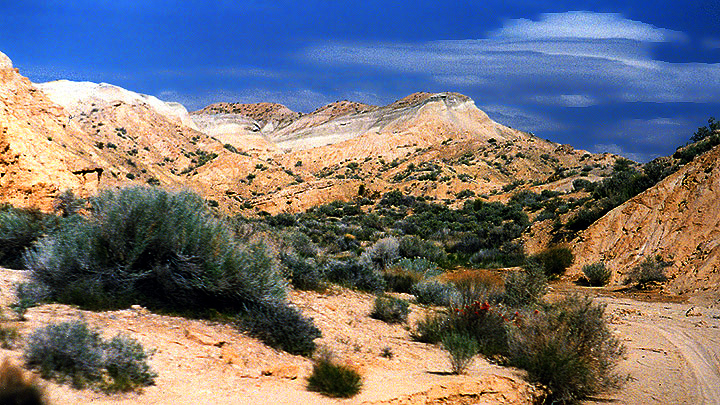
|
A view roughly eastward up one of many dry washes that penetrate the world-famous fossil bone-bearing sedimentary rocks of the Upper Member of the middle Miocene Barstow Formation at what many visitors call Fossil Bone Basin, Mojave Desert, California--strata dated radiometrically, in this specific portion of the stratigraphic section--at 15 to 13.4 million years old. This is, as a matter of fact, what paleontologists, stratigraphers, and geologists alike call the type locality for the Barstovian Stage of the middle Miocene, some 16 to 12.5 million years old, with which all correlative (of identical geologic age) strata in North America are scientifically compared. Weathering out along the slopes of the tuffaceous mudstones and siltstones along the slopes in the immediate distance can be found mineralized (usually silicified, replaced by silicon dioxide) teeth, jaws, skulls, and skeletal elements from a variety of extinct mammals, including extinct three-toed horses, camels, pronghorns, proboscideans, dog-bears, oreodonts, saber-tooth cats, and loads of rodents, among many others. Of course, such scientifically invaluable vertebrate fossils cannot be collected without a special use permit issued by the Bureau of Land Management--a permit given solely to individuals with at least a B.S. degree from an accredited university--or to fully qualified personnel representing a well-known, established museum. Taking photographs of the fossil bones, where found weathering out of the Barstow Formation, is not yet illegal, naturally. |
|
Within a reasonable driving distance of Barstow, seeming to appear out of nowhere in the midst of California's vast Mojave Desert, is a beckoning desert road that leads to one of the great terrestrial, land-laid vertebrate fossil-bearing areas in North America--a place many paleontology enthusiasts call Fossil Bone Basin, where abundant mineralized mammalian skeletal elements occur in variegated sedimentary strata carved through the ceaseless powers of erosive creativity into bold badlands roughly 19.3 to 13.4 million years old. This is the world-famous middle Miocene Barstow Formation, which appropriately enough is the type locality for the Barstovian Stage of the Miocene Epoch, deposited 15.9 to 12.5 million years ago. Every earth scientist in North America compares, contrasts, and evaluates vertebrate fossil evidence from all geologically time-equivalent rocks with the Barstow Formation exposures at Fossil Bone Basin, where some 66 species of mammals have been identified, including extinct three-toed horses, camels, pronghorns and proboscideans, among many others. Indeed, the list of fossil mammals continues to grow, as each field season in the Barstow beds seems to yield something significant, something that causes vertebrate paleontologists to reassess previous conclusions. The general area known colloquially as Fossil Bone Basin holds a special place in the paleontological and geological history of the Mojave Desert. It is a region in which scientific institutions from all across America (and world, for that matter) have collected at one time or another--ever since 1911 when H. S. Mourning, a private paleontology enthusiast from Los Angeles, sent to University California Berkeley (UCB) student John R. Suman a hundred or so fossil vertebrates he'd found in what today is sometimes called Fossil Bone Basin. Suman immediately directed that collection to the legendary vertebrate paleontologist John C. Merriam at UCB, who identified the specimens as teeth and foot bones from two species of extinct three-toed horses, genus Merychippus (one of which in the early 2000s was redescribed and renamed in honor of Suman, Scaphohippus sumani); horn fragments from a pronghorn, Merycodus; and loads of miscellaneous camel skeletal material, probably representing at least two distinct species. Mourning's collection certainly sparked an intensified interest in trying to unravel the historical geology of the Mojave Desert province. After collecting abundant material from the bonanza beds at Fossil Bone Basin, UCB paleontological expeditions once again lit out into the desert under Merriam's direction, this time searching for additional vertebrate fossil-yielding areas. And the scientific crews were remarkably successful. Merriam's "fossil posse" next investigated a rich vertebrate deposit from the late middle Miocene Dove Spring Formation exposed in the El Paso Mountains at today's Red Rock Canyon State Park. It's a rock deposit Merriam and associates then knew as the Ricardo Formation, a now obsolete geologic designation for an instantly recognizable, dramatically-exposed unit--since used as a backdrop for any number of Hollywood films, television shows and commercials--that continues to yield the internationally appreciated Ricardo Fauna. By the 1930s, almost all of the major bone-bearing Cenozoic Era fossil localities (65 million to 10,000 thousand years ago) scattered across California's Mojave Desert had been discovered, including, most famously: the late Pleistocene Manix Lake Beds; the late Pleistocene Rogers Lake Beds (now in Death Valley National Park); the lower to middle Pliocene Coso Mountains Fauna; the lower Pliocene Horned Toad Formation; the late middle Miocene Avawatz Mountains fauna; the late middle Miocene Copper Canyon Formation (contains perhaps the greatest concentration of the best-preserved Tertiary Period mammal trackways in North American; now in Death Valley National Park); the middle Miocene Bopesta Formation fauna; and the Oligocene Titus Canyon Formation fauna (now in Death Valley National Park). A supplemental important fossil vertebrate find on the Mojave Desert came in 1950, when Richard H. Tedford and R. Shultz discovered the significant Paleocene Goler Gulch Fauna. But by far the most abundant and well preserved vertebrate fossil material from California's Mojave Desert has been recovered from the Barstow Formation at Fossil Bone Basin. As a mater of fact, the Barstow yields one of the largest, most complete terrestrial Miocene vertebrate faunas ever described from North America. In addition to the pioneering work conducted by crews from the University California Berkeley (which still supports on-going research), representatives of many museums and institutions of higher learning continue to frequent the Barstow badlands--among them the Natural History Museum of Los Angeles County, where as a youngster I was allowed access to the innermost vertebrate paleontology catacombs after I'd donated several quality fossil vertebrates I'd picked up during a weekend desert outing with my parents to the late middle Miocene Dove Spring Formation, El Paso Mountains, outside of Red Rock Canyon State Park (the scientists were gracious, of course, gently reminding me that I really shouldn't have collected the bones without a permit...). There, I vividly recollect drawer after huge drawer of beautifully preserved vertebrates from the Barstow Formation; bountiful, showy horse teeth and a seemingly infinite variety of ornate pronghorn horns, in particular, captured my attention. Other museums actively excavating Barstow bone treasures include the San Bernardino County and Raymond Alf museums. Among the many universities still researching Barstow mysteries, probably the University California at Riverside pursues the bones most regularly. In the history of paleontological research at Fossil Bone Basin, certainly the most protracted collecting was undertaken by the Frick Laboratory of the American Museum of Natural History. Beginning in 1923, Childs Frick and personnel began what can accurately be described as an extended field campaign. Frick led the first teams from 1923 through 1930, then handed over the reigns to J. Wilson (1930-37), who in turn relinquished his lead role to C. Falkenbach (1940), followed by T. Galusha (1950-'52). During the first full field season, paleontologists happily learned that they didn't have to rely solely on surface prospecting for specimens--that, fortuitously, the Barstow Formation was amenable to quarrying, and the digs were given colorful, informal names; in all, Frick's crews worked over 25 unique, specific vertebrate fossil quarries, most of them paleontological bonanza bodies, producing in many instances amazing concentrations of mineralized mammal material. Unfortunately, Frick and his subsequent replacement teams can easily be accused of having been less than scientifically meticulous in their collecting procedures, and this inattention to geological detail threatened, for a time, to tarnish their legacy. For example, in the published documentation of their finds, Childs Frick--the man in charge--gives no geographic or even reliable stratigraphic evidence to help tie together the exact localities and age significance of his many fossil quarries. At first blush, it seemed all their work had been for for naught--essentially meaningless. True, they had described many new species of animals from the Barstow beds, but by apparently neglecting to give their specimens an accurate point of reference in the stratigraphic section, they had ostensibly perpetrated a disservice to science. Thus, when the United States Geological Survey (USGS) conducted its extensive mapping projects in the Mojave Desert from 1950 through 1955, it was impossible to adequately identify the many evidences of Frick's digs--they were, in effect, just so many holes in the ground, a frustrating guessing game. Partial redemption was slow in coming for Frick. When vertebrate paleontologists finally gained access to Frick's voluminous field notes, they discovered that Frick and personnel had actually continued to follow faithfully for many years an outdated stratigraphic subdivision of the Barstow Formation, originally formulated by a geologist in 1911. It wasn't until 1950-'52, near the conclusion of their field work, that a member of the team actually decided to map Fossil Bone Basin; his results agreed well with a definitive field mapping project by a USGS geologist many years later. Results of subsequent geological mapping projects in Fossil Bone Basin prove that the vertebrate fossil-bearing middle Miocene Barstow Formation is approximately 1,000 meters thick (3,280 feet) and can conveniently be divided into three distinct subunits, or members. The oldest unit is called the Conglomerate Member, around 200 meters in thickness (656 feet), and is best exposed around the scenic one-way loop trail that penetrates some of the most spectacular outcrops of the Barstow Formation. It's chiefly a gray-green conglomerate composed of granitic debris, grading into conglomerate and reddish sandstones to the south. Studies of directional clast orientations within the Conglomerate Member suggest that deposition flowed from the north and south, and then migrated to the southwest; geologists estimate that the ancestral Fossil Bone Basin probably was no wider than eight miles. A lithified layer of volcanic tuff near the base yielded a radiometric date of 19.3 million years. At the top of the Conglomerate Member, in a layer of volcanic tuff radiometrically calibrated between 16.5 and 16.3 million years, the first vertebrate fossils appear in the Barstow section; it is a tantalizing paucity of remains, but an extinct three-toed horse, an oreodont (an extinct artiodactyl; even-toed critter, sort of a cross between a pig and a sheep, but actually more related to a camel), a camel, and a pronghorn constitute the main take. The Conglomerate Member, with its coarse conglomeratic detritus, certainly suggests deposition under very high-energy conditions, probably the result of high-gradient watercourses rushing off dramatic extremes in nearby topography. Above the Conglomerate Member lies the Middle Member, a full 530 meters (1,739 feet) of fluviatile (river-deposited) conglomerate, conglomeratic sandstone and finer-grained lacustrine (lake) sandstones and shales dated at 16.3 to 15 million years old; the conglomerate probably came in from sources to the south and southwest, while the finer-grained sediments flowed in to a much deeper section of the basin from the east and northeast. The Middle Member is best exposed from points near the one-way scenic loop trail, eastward to the vicinity of the primitive Bureau of Land Management (BLM) campground. Two major tuff beds in the section yielded radiometric dates of 15.8 and 15.2 million years--an interval of geologic time, incidentally, that coincides nicely with deposition of what could well be the single richest deposit of Miocene marine vertebrates in the world--the Sharktooth Hill Bone Bed in the middle Miocene Round Mountain Silt member of the Temblor Formation, southern San Joaquin Valley, California; the Sharktooth Hill Bone Bed accumulated 15.9 to 15.2 million years ago. In the Middle Member of the Barstow Formation, the first abundant and well preserved vertebrates occur; they are concentrated within three separate, successively younger faunal divisions, and obvious evidences of abandoned fossil quarries, presumably dating from the Childs Frick expeditions of 1923 to the early 1950s, can be studied while hiking dry washes that penetrate the boldly sculpted Barstow exposures. The fantastically fossiliferous youngest Upper Member extends 270 meters (886 feet) above the Middle Member to the very top of the Barstow sequence. It's primarily a fine-grained interval of lacustrine (lake-deposited) shale, mudstone and claystone, with subordinate coarser-grained sandstones and conglomeratic material to the west and southwest. The mudstone-claystone deposits came in from the north and east sectors, but the sandstone and conglomeratic fluviatile constituents could have flowed basinward from the west and southwest. Two volcanic tuff beds in the section, plus a sandstone layer near the very youngest horizon bear radiometric dates of 14.8, 14.0, and 13.4 million years, respectively. Roughly 15 to 13.4 million years old, the Upper Member is best exposed along dry washes several miles removed from the scenic one-way loop trail. For folks wishing to visit the bone-bearing badlands, remember once again of course that removing vertebrate fossils from Fossil Bone Basin without a special use permit issued by the Bureau of Land Management is not allowed. The permit, by the way, is provided solely to trained personnel (with a minimum B.S. degree), representing either an accredited university or established, recognized museum, who seek to undertake scientifically justifiable research projects that can be verified as authentic by the petioned authorities: Even professional vertebrate paleontlogists must submit formal requests in proverbially triplicate, 20-page single-spaced format. But this is really not too discouraging for private paleontology buffs, because you can still hunt for fossil vertebrates there to your heart's content--with a camera in hand, of course. Instead of taking home the actual physical specimen, you can have loads of fun doing the next-best-thing: capture its image either on film, or with a digital device, just as it lies exposed in the Barstow sediments, 16.3 to 13.4 million years old. There are certainly many more bones yet to be found; do not became disheartened, as new material continues to come to light with each passing season. For example, in the chiefly mudstone-claystone facies of the Upper Member vertebrate fossils are often still astonishingly common, even after all those decades of scientific quarrying and surface collecting. Most representative outcrops of the highly fossiliferous Upper Member can be explored several miles removed from the scenic one-way loop trail and the excellent BLM campground. Here, along primitive jeep trails that follow the sinuous courses of dry pack-sand Mojave washes (visitors must remain on already established road and trails within Fossil Bone Basin), fossil seekers enter a paleontological paradise consisting of roughly 900 feet (around 270 meters) of greenish to tan tuffaceous mudstones and claystones, from which obvious 15 to 13.4 million year-old mammalian vertebrate remains continue to weather free. Some of the more prolific, sensational sites in this area were given informal, memorable names by the pioneering paleontologists--names based on the prevalence of specific kinds of fossil critters common to individual beds: camels, carnivores and rodents, for example. One particularly rich, world-famous fossil rodent locality was discovered during the Spring of 1922. While camped amidst the Upper Member, Pirie Davidson--a noted vertebrate paleontologist--in the company of legendary fossil collectors Annie Alexander and Louise Kellogg (working under the auspices of John C. Merriam of UC Berkeley)--happened upon an undistinguished mudstone hill about four to five feet high. Plastered all over that localized exposure were abundant jaws and teeth of many small mammals, including chipmunks, pocket mice, deer mice, and shrews. For years, that lone little fossil hill provided successive teams of technicians many seasons' worth of paleontological pleasure, the paleo-teams carefully excavating the Miocene matrix for readily identifiable tiny jaws, teeth, and post-cranial elements. On a related note, a year later, in 1923, Pirie Davidson actually named a new species of camel from the Barstow Formation in honor of its finder, Annie Alexander--Alticamelus alexandrae. There is really no special, magical technique for locating vertebrate fossils. Simply try to explore as much territory as possible. It usually helps to begin prospecting at the bases of hills, since all things being equal, gravity and such, bones that erode out of the sediments will in all likelihood tumble downslope. Try to find the little gullies and dry rivulets where water has created erosion gullies that might have exposed fossils. Hike slowly and deliberately upslope, watching for any telltale bone fragments. Whenever several fragments or splinters occur together, there's a good bet that you are near one of the fossiliferous zones in the Barstow Formation. Sometimes digging in the general vicinity of an especially rich concentration of fossil fragments helps to uncover quality specimens, the complete skeletal elements, teeth and jaws from the numerous species of extinct animals that lived in the ancestral Mojave Desert district all of those millions of years ago...although, technically, without a BLM permit, even digging for specimens is not allowed within the confines of Fossil Bone Basin. One might do well to remember this technique, though, when accompanying a professional paleontologist who's secured a permit. Whatever fossil-searching method is used, be sure to document with a GPS device (Global Positioning Satellite) the locations of your finds. This will help vertebrate paleontologists accurately identify your specimens when you return to civilization, since such specialists often require precise stratigraphic data to make a genus-species determination; not only that, but if you've found something genuinely remarkable, worthy of further study, scientists can then use your co-ordinates to go back and recover the mineralized remains. Generally speaking, a significant vertebrate fossil find is either, obviously, a complete bone, tooth, jaw, or skull--or, alternately, any specimen which has an articulating surface preserved; for instance, a ball or socket joint from a limb bone. Such remains are readily identifiable by an expert in vertebrate paleontology, although many scientists who specialize in the study of recent mammals (biologists)--or even archeologists, for that matter, should have little trouble stating the general type of critter involved--camel, horse, pronghorn, or proboscidean, for example. What you'll find in the Barstow badlands is a fossil vertebrate fauna composed of three dominantly abundant forms. In decreasing order of relative prevalence they are: the teeth, jaws, skulls, and post-cranial bones from (1) four species of extinct three-toed horses; (2) six species of camels; and (3) at least four species of pronghorns (horns frequently found, as well). But, that's not all, naturally. Fossil Bone Basin's exalted reputation among vertebrate paleontologists lies in its remarkable diversity of middle Miocene terrestrial life. Some 92 species of mammals have been described from the fossil beds; indeed, that's enough material for researchers to conclude that the specific ratio of predators to prey in the Barstow fauna is highly reminiscent of a present-day east African savanna. A few species are extremely rare, of course, their formal scientific descriptions based on perhaps fewer than a mere handful of specimens--but, in general, investigators agree that, among the more common specimens collected, the remains of smaller animals constitute a significant percentage of finds. Several years ago, for example, one expert attempted to erect a faunal zonation of the Barstow Formation based on the presence of four key species of rodents. That idea fell out of favor very quickly, though (as well it should have). Still, remains of smaller Barstow mammals continue to intrigue scientists. Diminutive middle Miocene dwellers recognized from Fossil Bone Basin include: a shrew mole; a hedgehog; one rabbit; an extinct rodent probably related to modern pocket gophers and kangaroo rats; two species of gophers; 13 species of Herteromyidae rodents--the pocket mice, kangaroo rats, and kangaroo mice; four species of squirrels; and six species of an extinct Cricetidae rodent related to modern deer mice. An additional larger rodent identified was a beaver. Among the larger animals recovered from the Barstow Formation, herbivores assume true dominance. And, the most common herbivores encountered are three species of the extinct three-toed horse Scaphohippus, a Barstow type originally called Merychippus, but officially renamed in the scientific literature in the early 2000s. Scaphohippus is directly ancestral to the modern horse; it stood about three to five feet high at the shoulder (a little less than a meter to 1.5 meters), and like earlier horses in the geological record it still possessed three toes, though the outer two had now become vestigial, never again reaching the ground. Scaphohippus had relatively high-crowned teeth, suggesting an adaptive ability to masticate tough vegetation, possibly grasses. Another notable horse observed is Megahippus, which stood only slightly smaller than a modern horse; Megahippus had lower-crowned teeth, though, and probably fed on the softer vegetation of shrubs and trees. Based on the shear numbers of fossils recovered, camels are the second-most commonly observed vertebrate remains in the Barstow Formation. At least 6 separate species have been identified, all of varying shapes and sizes. Smallest of the lot was Paramiolabis minutus, which stood only two feet high at the shoulder (60 centimeters); probably it resembled in behavior and size a present-day small deer. Protolabis was one of several kinds of medium-sized camels, with a life-style and appearance apparently more like a modern deer than a current camel. Aepycamelus, on the other hand, was a long-legged, long-necked fellow of giraffe-like lifestyle and size, adapted to browsing on vegetation higher up in the trees. Next in relative abundance were several small, artiodactyl (even-toed) horned animals, usually referred to as pronghorns--most only slightly larger, perhaps, than a modern fawn. Among these, Mercycodus--with its distinctive pair of forked horns--was by far the most common; such specimens are certainly prolific, and vast numbers of Barstow Formation Merycodus horns have likely found their way to any number of vertebrate paleontology departments throughout North America. Rakomeryx grew to the size of a modern impala, bearing two long, curved horns. Other pronghorn genera include Merriamoceras, which displayed diminutive moose-like horns; and Ramoceras, with curious tripod-configured horns. Several additional herbivores ranged through the Barstow savanna, though they were preserved in far fewer numbers than the three dominants. For example, only a single rhinoceros is known from Fossil Bone Basin, called scientifically, Aphelops; somewhat smaller and more slender than the modern Sumatran rhinoceros, Aphelops also possessed longer legs, an anatomical adaption that suggests that it might have been able to run faster than its present-day analog. Among the peccaries identified, Dyseohyus is best known; in appearance and behavior, all Barstow peccaries probably resembled today's javelina of the southwestern United States. Another group of plant eaters, the oreodonts--a curious mammalian experiment often categorized as a cross between a pig and a sheep (though they were more closely related to a camel)--were on they way to eventual extinction during Miocene Barstow times. In the Oligocene of North America, though, particularly South Dakota, oreodonts are among the most abundant fossil mammals reported; a single tapir-like oreodont called Brachycrus occurs in the oldest vertebrate-producing Barstow Formation horizon. Its teeth were adapted to grinding softer deciduous vegetation along the watercourses. The largest herbivore documented from Fossil Bone Basin is the proboscidean Gomphotherium, which grew slightly smaller than a modern elephant; such proboscideans first appear in the geologic record in North America approximately 15 million years ago. Supplementing the significant Barstow Gomphotherium skeletal material are many nicely preserved trackways; in the Middle Member of the Barstow Formation, exposed along the one-way loop trail, several reworked, water-laid volcanic tuffs beds reveal easily recognizable Gomphotherium steps, helping ichnologists determine how the animal behaved in life. Preying on the plant-eaters was a great diversity of carnivores. The most commonly encountered in the field belong to members of the dog subfamily Borophaginae; modern dogs reside within the subfamily Caninae--so, as many scientists note, the relationship is somewhat comparable to that of chimpanzees (Barstow dogs) to modern humans (present-day dogs). The Barstow borophagine canids came in a wide variety of shapes and sizes, with habitats and behaviors that anticipated present-day wild canine activity. Cymarctus, for example, was analogous to the fox, while Tamarctus and Aelurodon more closely resembled coyotes and the gray wolf, respectively. Cynarctoides looked and behaved like the modern mink or fisher, and Protepicon was the famous Barstow "hyaenoid dog," with a shortened muzzle and powerful jaws adapted for scavenging and crushing bones--perhaps seeking the marrow within. Another group of Barstow predators resembled an unusual cross between a bear and dog. The chief example was a true carnivorous terror of middle Miocene times, Amphicyon--commonly called a "bear-dog," as it occupied an adaptive morphological position between modern dogs and bears. This bad boy resembled a modern grizzly bear--and probably filled an ecological niche similar to today's bears--but its more streamlined body and slightly longer legs likely permitted the creature to run down even the largest of prey. Hemicyon was the so-called "running bear" of its age. More like a modern dog than a bear in overall morphology, though, Hemicyon was stockier and slightly larger than a gray wolf. It walked on its toes instead of a flat-footed gait and first appears in the North American geological record roughly 15 million years ago. Along with the dogs and bear-dogs lived a number of mustelids--that is, for example, weasels, badgers, minks and wolverines. Virtually identical to minks or weasels were Miomustella and Plionictus, while Brachypsalis grew to nearly wolvarine size and probably had a similar lifestyle. Among the Barstow cats, two types are quite representative. Nimravides was a saber-tooth cat from the older family Nimravidae, not a member of the modern Felidae which, first appearing in the fossil record approximately 15 million years ago, includes all true cats. In size, Nimravides was somewhere between a lynx and a cougar. The most common true cat in the Barstow fauna is Pseudaeluris, which in most morphological characteristics resembles a modern cougar. In addition to the many mammals, paleontologists have also recovered several other kinds of specimens from the middle Miocene strata of Fossil Bone Basin. These include: a tortoise; birds (most famously a hawk and flamingo); freshwater mollusks (gastropods and pelecypods); 24 species of diatoms (microscopic single-celled photosynthesizing algae)--plus, such important macroscopic botanic remains as fossil leaves from a buckthorn and two varieties of evergreen oak--and, petrified woods representing palm, juniper, and poison oak. The environment suggested by the multitude of fossils and the sedimentary rocks within which they occur is quite illuminating. In general, the Miocene climate was certainly cooler and less arid, with perhaps 15 to 25 inches (38.1 to 63.5 centimeters) of annual precipitation delivered during both summer and winter months. Vegetation surrounding the lake basin of deposition probably resembled modern oak-juniper woodlands now common to southern Arizona and northern Mexico, where summer monsoonal precipitation develops; abundant lush deciduous plants grew along the watercourses, ponds and springs, providing nourishment for many Barstow herbivores whose lower-crowned teeth were adapted to process softer plants; a greater variety of conifers (fir, pine and spruce) probably thrived at slightly higher elevations. A palm preserved in the Barstow beds is in many key botanic characteristics close to a variety that now grows in northern Mexico. Too, the ratio of Barstow Formation herbivores to the specific diversity of predators suggests that savannas (ecosystems where trees are sufficiently spaced so that the canopy remains open) similar to those in modern east Africa dominated certain portions of the terrain. Diatoms (microscopic single-celled algae) preserved in the vertebrate fossil-bearing section of the Barstow Formation, 16.3 to 13.4 million years ago, point to cool, clear lake waters whose normal freshwater alkalinity was interrupted on occasion by evaporative periods and enormous quantities of volcanic ash ejecta which, eventually reworked by erosion and redeposited as firm mudflats, provided a perfect medium (analogous to wet concrete) to preserve the trackways of horses, camels, pronghorns, gomphothere proboscideans, and bear-dogs. The trackways are now found along the tilted and folded bedding planes of those lithified volcanic tuffs. That such an abundance of well preserved vertebrate material lies within reworked tuff beds and tuffaceous mudstones suggests that perhaps periodic episodes of cataclysmic volcanism repeatedly devastated successive landscapes over the course of approximately three million years, cyclically wiping out vast herds of herbivores and their predators. Flooding then fortuitously delivered carcasses and myriads of disarticulated skeletal elements to the ash-laden lakes and watercourses, where the silica-rich environment guaranteed faithful mineral replacements of the bones. Today, 16 to 13.4 million years later, the animals once entombed in the volcanic slush of a Miocene lake weather out in stony profusion on a vast desert under conditions of extreme aridity--as low as five inches (12.5 centimeters) of precipitation per year, on average. It is a land most comfortably visited during mid to late Fall and early to mid Spring. Expect sudden high winds and great fluctuations of temperatures year-round, though, since Fossil Bone Basin lies in the midst of the great Mojave Desert and unpredictable meteorology is, well, predictable in a paradoxical sense. Remember, too, that Fossil Bone Basin is a federally protected region. This means that the removal of any fossil specimens without a BLM special use permit is absolutely forbidden. Of course, the way to get around this regulation is to bring along a camera and capture your fossil game in situ as it comes to light in the ancient Barstow Formation sediments, the mineralized remains of a Miocene animal that played out its life in savannas and oak-juniper woodlands among an association of predators and prey reminiscent of modern east Africa. |
 |
Click on the image for a larger picture--and for several additional images of three-dimensional specimens recovered from calcareous concretions, middle Miocene Barstow Formation, Fossil Insect Canyon, Mojave Desert, California. This is a fossil adult female midge, called scientifically Dasyhelea australis antiqua, dissolved out of a calcareous concretion with a diluted acid solution by Farrall S. Smith--who graciously provided me with images of his finds for use at my web site. Specimen in actual size is approximately 3 millimeters long (about an eighth of an inch). It is most closely related to the modern Dasyhelea australis australis, now living on the islands of Islas Juan Fernandez, about 400 miles west of Santiago, Chile. Photomicrographs graciously provided by Mr. Farrall S. Smith, who gave the following information regarding his techniques: "Rather than microscopically examining cleaned, dry material, I place the material in a glass Petri dish and cover the material with clean water. In the wetted state, color & detail really jump out. I make two visual passes over the material; once with transmitted light up from the bottom (best for internal detail of the fossil) and once with reflected light from above (best for external detail and coloration). This technique makes for sharp & detailed micro-photographs." |
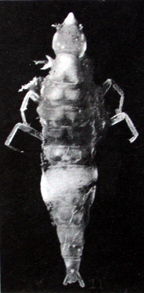 |
Click on the image for a larger picture--and for several additional images of three-dimensional insect, crustacean, and spider specimens recovered from calcareous concretions in the middle Miocene Barstow Formation, Fossil Insect Canyon, Mojave Desert, California. All but eight of the images came from a specific Public Domain source. This is a mature larva of a predacious diving water beetle, Shistomerus californense--a co-dominant in the Barstow fossil arthropod fauna. It is 8 millimeters long (about a third of an inch). It's most closely related to the living water beetle Dronectes striatellus, widely distributed throughout the southwestern United States, and was dissolved free from a calcium carbonate concretion with a diluted solution of formic acid. |
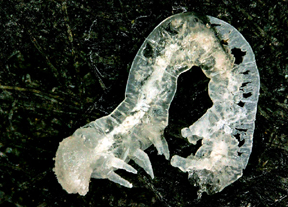 |
Click on the image for a larger picture--and for several additional images of three-dimensional arthropod specimens. This is a silcified, fully three-dimensional butterfly catterpillar (undescribed in the scientific literature), order Lepidoptera, dissolved out of a calcareous concretion from the middle Miocene Barstow Formation of Fossil Insect Canyon, California, by Mr. John E. Jenkins. Image courtesy the Natural History Museum of Los Angeles County, under the terms of the Attribution 4.0 International (CC BY 4.0) license. I edited and processed all the images with photoshop. Here are additional specimens that Mr. John E. Jenkins dissolved out of Fossil Insect Camyon's calcareous concretions from the middle Miocene Barstow Formation; in 2020, he donated his collection to the Natural History Museum of Los Angeles County, where technicians photographed the fossils. I present several of those fossil photographs here with permission from the Natural History Museum of Los Angeles County, under terms of the Attribution 4.0 International (CC BY 4.0) license. I edited and processed all the images with photoshop. |
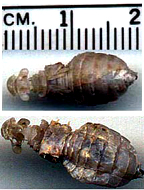 |
Click on the image for a larger picture of this three-dimensional insect recovered from the middle Miocene Barstow Formation, Fossil Insect Canyon, Mojave Desert, California. The image depicts reverse sides of the same fossil dragonfly larva, called scientifically Orthemis sp. (about four-fifths of an inch long), collected by Keith and Sharon Thompson sometime in 1998. It's approximately 17 million years old and most closely resembles a Caribbean dragonfly species, Orthemis ferruginia. Here's what Keith and Sharon had to say about the fossil specimen, when they posted it at a now-defunct, belly-up, fossil forum a number of years ago. "Dorsal and ventral views of a dragonfly
nymph from the Barstow Formation, California. We recovered the
nymph and other arthropods (mostly pieces)from calcareous nodules
created during the Miocene. The fossils were deposited in lacustrine
sediments and later embedded in the nodules. |
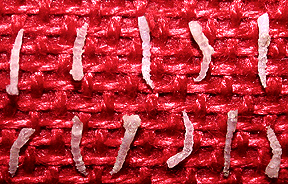 |
Click on the image for a larger picture--and for several additional images of three-dimensional insect specimens I have recovered from calcareous concretions collected from the middle Miocene Barstow Formation, Fossil Insect Canyon, Mojave Desert, California. After dissolving the insects out of calcium carbonate (limestone) concretions with a diluted solution of formic acid, I photographed them with a Nixon CoolPix 995 digital camera in indirect lighting, with a flash unit. Here is a series of silicified--replaced by the mineral chalcedony (silicon dioxide)--midge pupae from the middle Miocene Barstow Formation, Mojave Desert, California. For perspective, the pupa at far right, in the upper row, is 4 millimeter long (about a sixth of an inch). Scientifically, it's called Dasyhelea australis antiqua. This particular species of midge, interestingly enough, is most closely related to the modern Dasyhelea australis australis, now living on the islands of Islas Juan Fernandez, about 400 miles west of Santiago, Chile. |
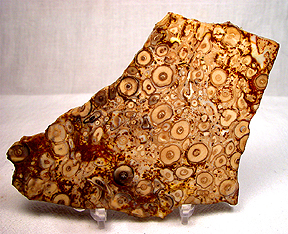 |
Click on the image for a larger picture--Here's a slab of agate from Fossil Insect Canyon that's been professionally cut and polished to reveal cross-sections of numerous petrified palm roots; genus-species undetermned. The petrified palm horizon occurs near the base of the Barstow Formation in Fossil Insect Canyon, well below the fossil arthropods (inects, spiders, water mites, and fairy shrimp) preserved in the calcareous concretions. As such, the agatized palm roots are probably close to 19 million years old and cannot be used with any degree of confidence to help determine paleoenvironmental conditions present during formation of the paleoentomologically significant calcareous concretions. Image courtesy an anonymous photographer at a specific web page. |
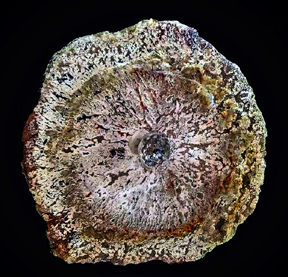 |
Click on the image for a larger picture-- Stromatolitic cyanobacterial algal accumulations on a piece of wood at the center. From the middle Miocene Barstow Formation, Mojave Desert, California. Specimen in photograph at left is eight and a half inches in diameter by eight and three-quarters inches; it's a professionally cut and polished cross-section of the paleobotanic remain. Images courtesy anonymous photographers at specific web pages. |
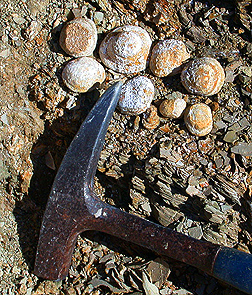 |
Click on the image for a larger picture, plus additional photographs of fossiliferous calcareous concretions from the middle Miocene Barstow Formation. They are approximately 17 million years old. Here are several freshly dug world-famous calcareous concretions from microlaminated green shales exposed in Fossil Insect Canyon, Mojave Desert, California. The calcium carbonate (limestone) concretions yield up a genuine bonanza of fantastically preserved three-dimensional insects, spiders, water mites, fairy shrimp, copepods (a tiny crustacean, of which Cyclops is the best-known freshwater type), ostracods (a minute bivalve crustacean), cladocerans (a small crustacean often called a "water flea"), and diatoms (microscopic single-celled algae. In order to secure the fossils, the concretions must be dissolved in a dilute solution of acid; many collectors prefer to use a gentle organic variety, such as formic acid, or even acetic (glacial acetic--not the kind found in vinegar)--although excellent results can also be obtained with muriatic acid, commercially available, highly potent hydrochloric acid. The mineralized fossil specimens, impervious to such acids, preserved as they are by chalcedony quartz (silicon dioxide) and celestite (strontium sulfate), primarily, can then be recovered from the insoluble residues remaining from the chemical reaction. |
| Please Note--I observed, encountered, all fossil vertebrates imaged here in Fossil Bone Basin during occasional hikes with a Nikon CoolPix 995 digital camera through the bone-bearing badlands of the middle Miocene Barstow Formation; photographs later processed with Photoshop. |
 |
Click on the image for a larger picture, plus additional photographs of various mammalian vertebrate material from the middle Miocene Barstow Formation of Fossil Bone Basin, Mojave Desert, California. This is an upper cheek tooth from an extinct three-toed horse, called Scaphohippus sp.--whose rather common to abundant skeletal elements in the Barstow beds were formerly assigned to the genus Merychippus--spotted in badlands eroded from the youngest sedimentary deposits in the middle Miocene Barstow Formation, Mojave Desert, California; that means that the specimen is 15 to 13.4 million years old; the grinding surface is 24 millimeters (about an inch) across. Identified by Dr. Xiaoming Wang, Curator Vertebrate Paleontology, Natural History Museum of Los Angeles. (Genus identification is mine). |
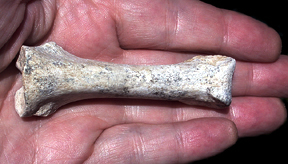 |
Click on the image for a larger picture, plus additional photographs of various vertebrate fossil material from the middle Miocene Barstow Formation of Fossil Bone Basin, Mojave Desert, California. Here is a proximal phalanx (one of the toe bones) from a camel, Upper Member of the middle MIocene Barstow Formation. Various skeletal elements from several species of camels are among the most common finds throughout the bone-bearing badlands, Fossil Bone Basin, Mojave Desert, California. 80 millimeters long (slightly over three inches). 15 to 13.4 million years old |
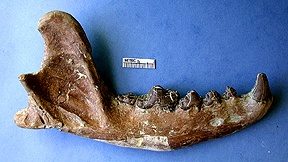 |
Click on the image for a larger picture, plus additional photographs of various vertebrate fossil material from the middle Miocene Barstow Formation of Fossil Bone Basin, Mojave Desert, California. These are photographs courtesy: The University California Museum of Paleontology, used here per parameters provided by the Creative Commons license. A lower jaw from a Borophagine canid (the bone-crushing dog), Middle Member of the middle Miocene Barstow Formation, Fossil Bone Basin, Mojave Desert, California. called scientifically, Protepicyon raki. Scale in image is two centimeters long (slightly over three-quarters inch). 16 to 15 million years old. Photograph by Patricia Holroyd, courtesy Copyright © 2007 University of California Museum of Paleontology, used here per parameters provided by the Creative Commons license. |
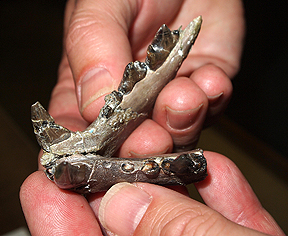 |
Click on the image for a larger picture, plus additional photographs of various vertebrate fossil material from the middle Miocene Barstow Formation of Fossil Bone Basin, Mojave Desert, California. These are photographs courtesy an individual who goes by the cyber-name coolislandsong24; the fossil specimens presently reside in the following museum vertebrate paleontological repositories--Raymond Alf Museum of Paleontology; and the San Bernardino County Museum. A lower jaw from a saber-tooth cat, Upper Member of the middle Miocene Barstow Formation, Fossil Bone Basin, Mojave Desert, California. Called scientifically, genus Nimravides. 13.6 to 13.4 million years old. A specimen that presently resides in the San Bernardino County Museum. Photograph courtesy an individual who goes by the cyber-name coolislandsong24. I edited and processed the photo through photoshop. |
 |
Click on the image for a larger picture. A vintage 1923 press-release photograph of "the man of the Miocene Barstow hour," so to speak: H. S. Mourning, he who in 1911 first discovered fossil bones in the now world famous middle Miocene Barstow Formation, on property he had claimed in what's colloquially called Fossil Bone Basin, Mojave Desert, California. Photographs courtesy an individual who goes by the cyber-name historicimages-gallery. |
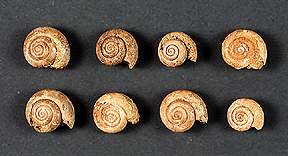 |
Click on the image for a larger picture. Fossil fresh water gastropods (snails) from the middle Miocene Barstow Formation, Fossil Bone Basin, Mojave Desert, California. Largest of the specimens is approximately a half inch in diameter (12.7mm); called scientifically Helminthoglypta alfi. Its closest living relative presently inhabits the area around Victorville, California, Mojave Desert, "on dry rocky mountains slopes, among boulders and in rock slides or under rocks and leaves beneath cottonwood trees along the Mojave River." Quote is from a specific public domain document. Photograph courtesy the California Academy of Sciences, per the parameters defined in the Creative Commons license. I edidted and processed the image through photoshop. |
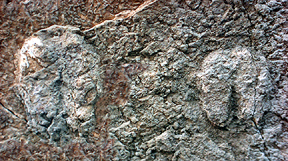 |
Click on the image for a larger picture. Two camel tracks from the middle Miocene Barstow Formation, preserved on the bedding plane of volcanic tuff roughly 15 million years old--hardened material deposited into clear lake waters whose normal freshwater alkalinity was interrupted on occasion by evaporative periods and enormous quantities of volcanic ash ejecta which, eventually reworked by erosion and redeposited as firm mudflats, provided a perfect medium (analogous to wet concrete) to preserve the trackways of horses, camels, pronghorns, gomphothere proboscideans, and bear-dogs. The trackways are now found along the tilted and folded bedding planes of those lithified volcanic tuffs. |
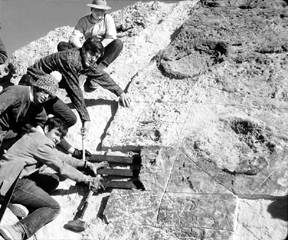 |
Click on the image for a larger picture. A year 1969 scientific excavation of two proboscidean tracks (large circular depressions in right half of photograph) from the middle Miocene Barstow Formation, preserved on the bedding plane of volcanic tuff radiometrically dated at 14.8 million years old--hardened material deposited into clear lake waters whose normal freshwater alkalinity was interrupted on occasion by evaporative periods and enormous quantities of volcanic ash ejecta which, eventually reworked by erosion and redeposited as firm mudflats, provided a perfect medium (analogous to wet concrete) to preserve the trackways of horses, camels, pronghorns, gomphothere proboscideans, and bear-dogs. The trackways are now found along the tilted and folded bedding planes of those lithified volcanic tuffs. Photograph from a specific scientific paper. |
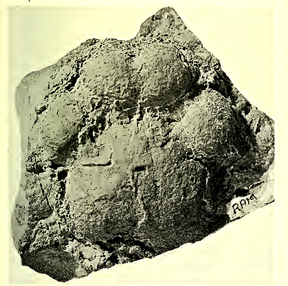 |
Click on the image for a larger picture. A cat track--probably genus Pseudaleurus--from the middle Miocene Barstow Formation, preserved on the bedding plane of volcanic tuff radiometrically dated at 14.8 million years old--hardened material deposited into clear lake waters whose normal freshwater alkalinity was interrupted on occasion by evaporative periods and enormous quantities of volcanic ash ejecta which, eventually reworked by erosion and redeposited as firm mudflats, provided a perfect medium (analogous to wet concrete) to preserve the trackways of horses, camels, pronghorns, gomphothere proboscideans, and bear-dogs. The trackways are now found along the tilted and folded bedding planes of those lithified volcanic tuffs. Photograph courtesy Raymond M. Alf. |
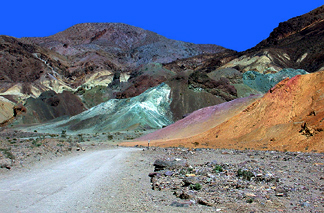 |
Click on the image for a larger picture, plus more on-site photographs from Fossil Insect Canyon. Parked along the non-maintained dirt trail in the midst of Fossil Insect Canyon. Within this view, colorful but organically barren volcanic rocks practically engulf the fossiliferous horizon. Only that narrow pale brown strip of the 17 million year-old middle Miocene Barstow Formation at roughly upper left, lying just below the reddish-brown dacite extrusives, contains common to abundant calcium carbonate concretions, within which a genuine paleo-bonanza of fossil insects, arachnids, crustaceans, and even diatoms can be dissolved free of their calcareous matrixes. In order to reach most of the paleontologically significant outcrops of the Barstow Formation in Fossil Insect Canyon, visitors must hike well away from the main trail through rugged, unforgiving Mojave Desert terrain. |
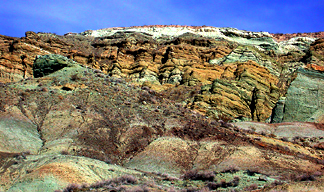 |
Click on the image for a larger picture, plus additional photographs from the bone-bearing badlands at Fossil Bone Basin. Here is a distinctive and well exposed geologic section of the middle Miocene Barstow Formation at Fossil Bone Basin. Massive greenish to brown fluviatile (deposited in ancient streams and rivers) sandstones underlie the world-famous white Skyline Tuff, appropriately enough situated at the skyline--a hardened layer of solidified volcanic ash that erupted from a long-vanished volcano some 15 million years ago. Strata deposited just below the Skyline Tuff (some 15.2 million years) to a point several hundred feet above it (15 to 13.4 million years old) yield the most abundant fossil vertebrate material recovered from the Barstow Formation--a fantastic array of mammals, including camels, horses, pronghorns, oreodonts, gomtherium proboscideans, saber-tooth cats, canids, and numerous varieties of rodents, among many others. It is certainly one of the most fossiliferous bone-bearing, Miocene terrestrial geologic rock units in North America--the type locality for the Barstovian Stage of the Miocene Epoch--roughly 16 to 12.5 million years ago. |
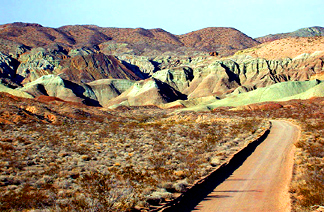 |
Click on the image for a larger picture, and for additional photographs from the one-way loop trail at Fossil Bone Basin. At Fossil Bone Basin, the Bureau of Land Management administers a wonderful one-way scenic loop trail that penetrates some of the best-exposed outcrops of the middle Miocene Barstow Formation. Here, the dirt trail gradually carries the traveler toward wildly eroded, varicolored exposures of a predominantly sandstone-tuff sedimentary complex representing the Lower and Middle members of the Barstow Formation, deposited primarily in streams and rivers some 19.3 to 15 million years ago. Here occur several fossiliferous horizons that bear important suites of mineralized skeletal elements from many extinct mammals, plus beds of water-laid, re-worked tuff that reveal many trackways of extinct horses, camels, pronghorns, proboscideans, and bear-dogs. |
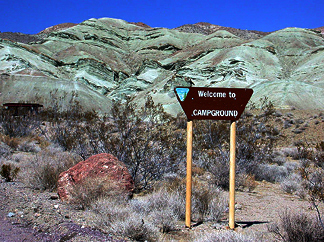 |
Click on the image for a larger picture, plus more photographs of Barstow Formation strata from the campground at Fossil Bone Basin. The United States Bureau of Land Management (BLM), which administers the millions of acres of Public Lands throughout the United States, has established a fine campground within what's colloquially called by many visitors Fossil Bone Basin. All strata in background belong to the Middle Member of the world-famous middle Miocene Barstow Formation, here a heterogeneous mixture of mudstones, sandstones, gypsum (calcium sulfate), volcanic tuffs and minor limestone horizons deposited in lakes and streams some 16.3 to 15 million years ago. Many lithified (hardened) layers of volcanic tuff here bear common to abundant tracks of extinct three-toed horses, camels, pronghorns, proboscideans, and bear-dogs. |

|